Analysis of Nightingale's Environmental Theory in Patient Management
VerifiedAdded on 2023/03/17
|5
|1450
|58
Essay
AI Summary
This essay examines Florence Nightingale's Environmental Theory and its application in the care of a 68-year-old patient, Mrs. Adams, who was recently discharged from the hospital after a mastectomy and diagnosed with hypertension, breast cancer, and diabetes. The essay highlights the importance of environmental factors, such as fresh air, clean water, hygiene, and light, in patient recovery. It analyzes Mrs. Adams's living conditions, which were deemed unsuitable, and discusses how the nurse would implement Nightingale's theory to improve her environment and overall health. The care plan prioritizes ventilation, light, cleanliness, and managing the patient's living situation. The essay emphasizes the theory's relevance in post-operative care and its potential to enhance patient outcomes by focusing on the patient's surroundings and providing a clean and safe environment.
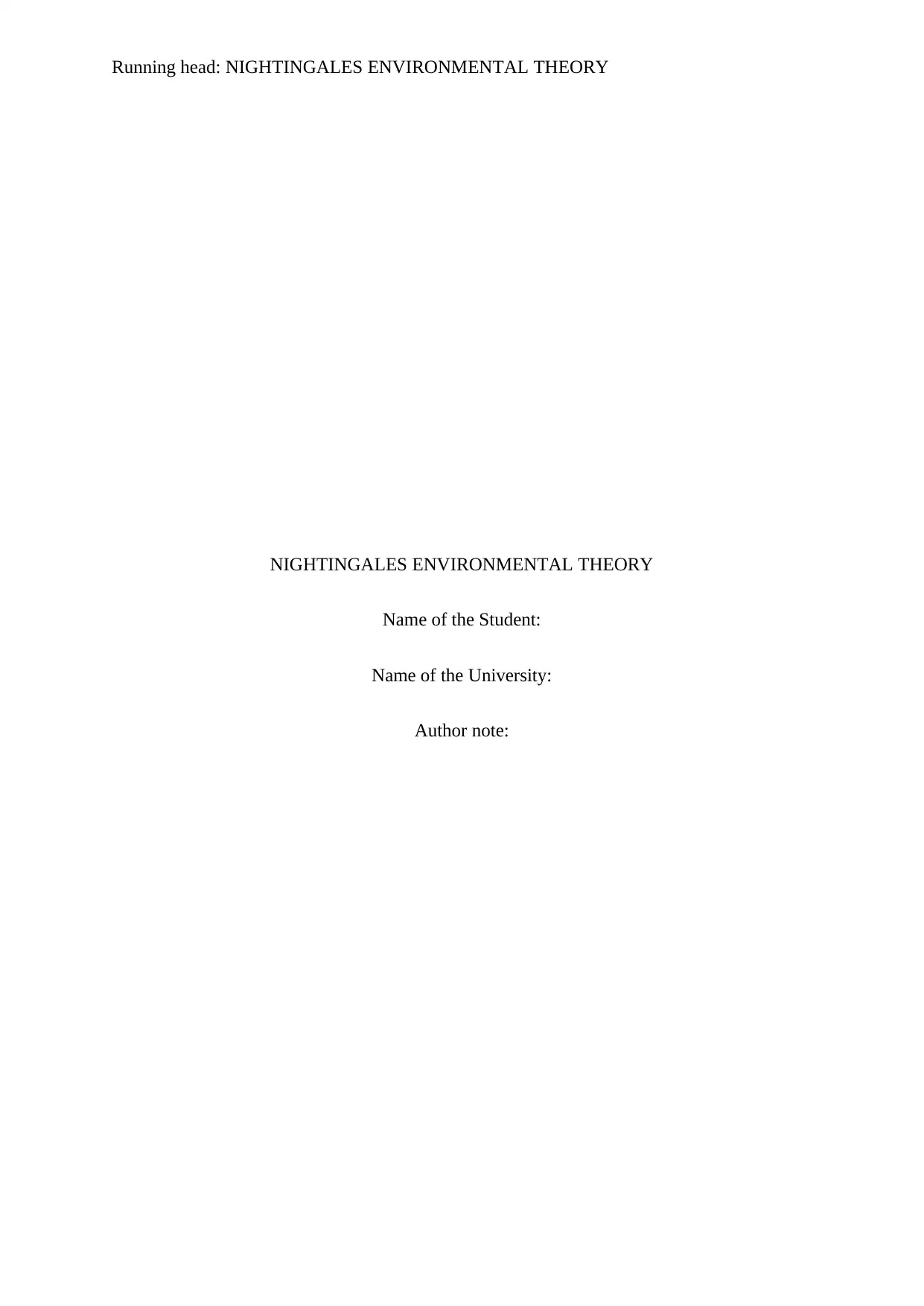
Running head: NIGHTINGALES ENVIRONMENTAL THEORY
NIGHTINGALES ENVIRONMENTAL THEORY
Name of the Student:
Name of the University:
Author note:
NIGHTINGALES ENVIRONMENTAL THEORY
Name of the Student:
Name of the University:
Author note:
Paraphrase This Document
Need a fresh take? Get an instant paraphrase of this document with our AI Paraphraser
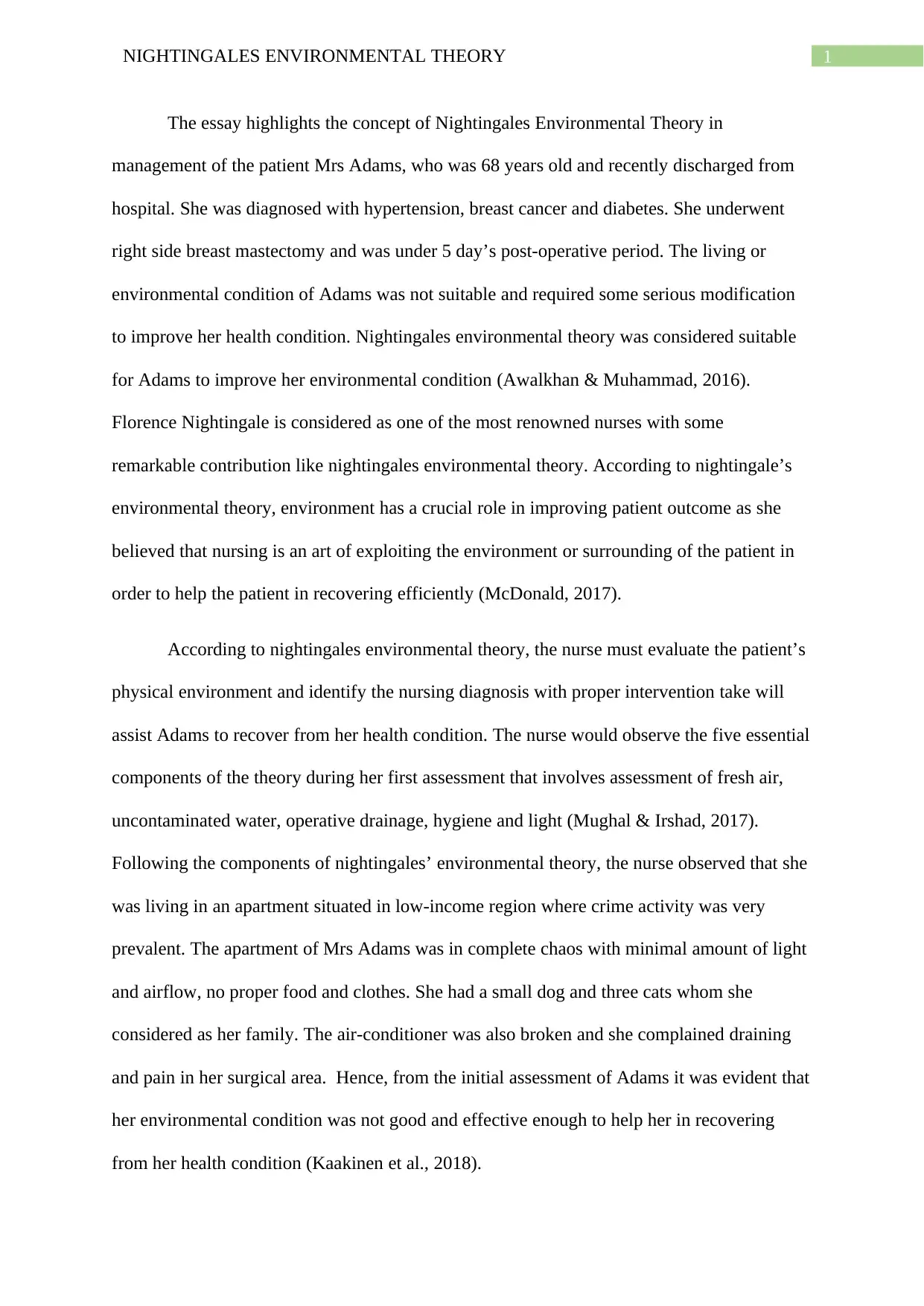
1NIGHTINGALES ENVIRONMENTAL THEORY
The essay highlights the concept of Nightingales Environmental Theory in
management of the patient Mrs Adams, who was 68 years old and recently discharged from
hospital. She was diagnosed with hypertension, breast cancer and diabetes. She underwent
right side breast mastectomy and was under 5 day’s post-operative period. The living or
environmental condition of Adams was not suitable and required some serious modification
to improve her health condition. Nightingales environmental theory was considered suitable
for Adams to improve her environmental condition (Awalkhan & Muhammad, 2016).
Florence Nightingale is considered as one of the most renowned nurses with some
remarkable contribution like nightingales environmental theory. According to nightingale’s
environmental theory, environment has a crucial role in improving patient outcome as she
believed that nursing is an art of exploiting the environment or surrounding of the patient in
order to help the patient in recovering efficiently (McDonald, 2017).
According to nightingales environmental theory, the nurse must evaluate the patient’s
physical environment and identify the nursing diagnosis with proper intervention take will
assist Adams to recover from her health condition. The nurse would observe the five essential
components of the theory during her first assessment that involves assessment of fresh air,
uncontaminated water, operative drainage, hygiene and light (Mughal & Irshad, 2017).
Following the components of nightingales’ environmental theory, the nurse observed that she
was living in an apartment situated in low-income region where crime activity was very
prevalent. The apartment of Mrs Adams was in complete chaos with minimal amount of light
and airflow, no proper food and clothes. She had a small dog and three cats whom she
considered as her family. The air-conditioner was also broken and she complained draining
and pain in her surgical area. Hence, from the initial assessment of Adams it was evident that
her environmental condition was not good and effective enough to help her in recovering
from her health condition (Kaakinen et al., 2018).
The essay highlights the concept of Nightingales Environmental Theory in
management of the patient Mrs Adams, who was 68 years old and recently discharged from
hospital. She was diagnosed with hypertension, breast cancer and diabetes. She underwent
right side breast mastectomy and was under 5 day’s post-operative period. The living or
environmental condition of Adams was not suitable and required some serious modification
to improve her health condition. Nightingales environmental theory was considered suitable
for Adams to improve her environmental condition (Awalkhan & Muhammad, 2016).
Florence Nightingale is considered as one of the most renowned nurses with some
remarkable contribution like nightingales environmental theory. According to nightingale’s
environmental theory, environment has a crucial role in improving patient outcome as she
believed that nursing is an art of exploiting the environment or surrounding of the patient in
order to help the patient in recovering efficiently (McDonald, 2017).
According to nightingales environmental theory, the nurse must evaluate the patient’s
physical environment and identify the nursing diagnosis with proper intervention take will
assist Adams to recover from her health condition. The nurse would observe the five essential
components of the theory during her first assessment that involves assessment of fresh air,
uncontaminated water, operative drainage, hygiene and light (Mughal & Irshad, 2017).
Following the components of nightingales’ environmental theory, the nurse observed that she
was living in an apartment situated in low-income region where crime activity was very
prevalent. The apartment of Mrs Adams was in complete chaos with minimal amount of light
and airflow, no proper food and clothes. She had a small dog and three cats whom she
considered as her family. The air-conditioner was also broken and she complained draining
and pain in her surgical area. Hence, from the initial assessment of Adams it was evident that
her environmental condition was not good and effective enough to help her in recovering
from her health condition (Kaakinen et al., 2018).
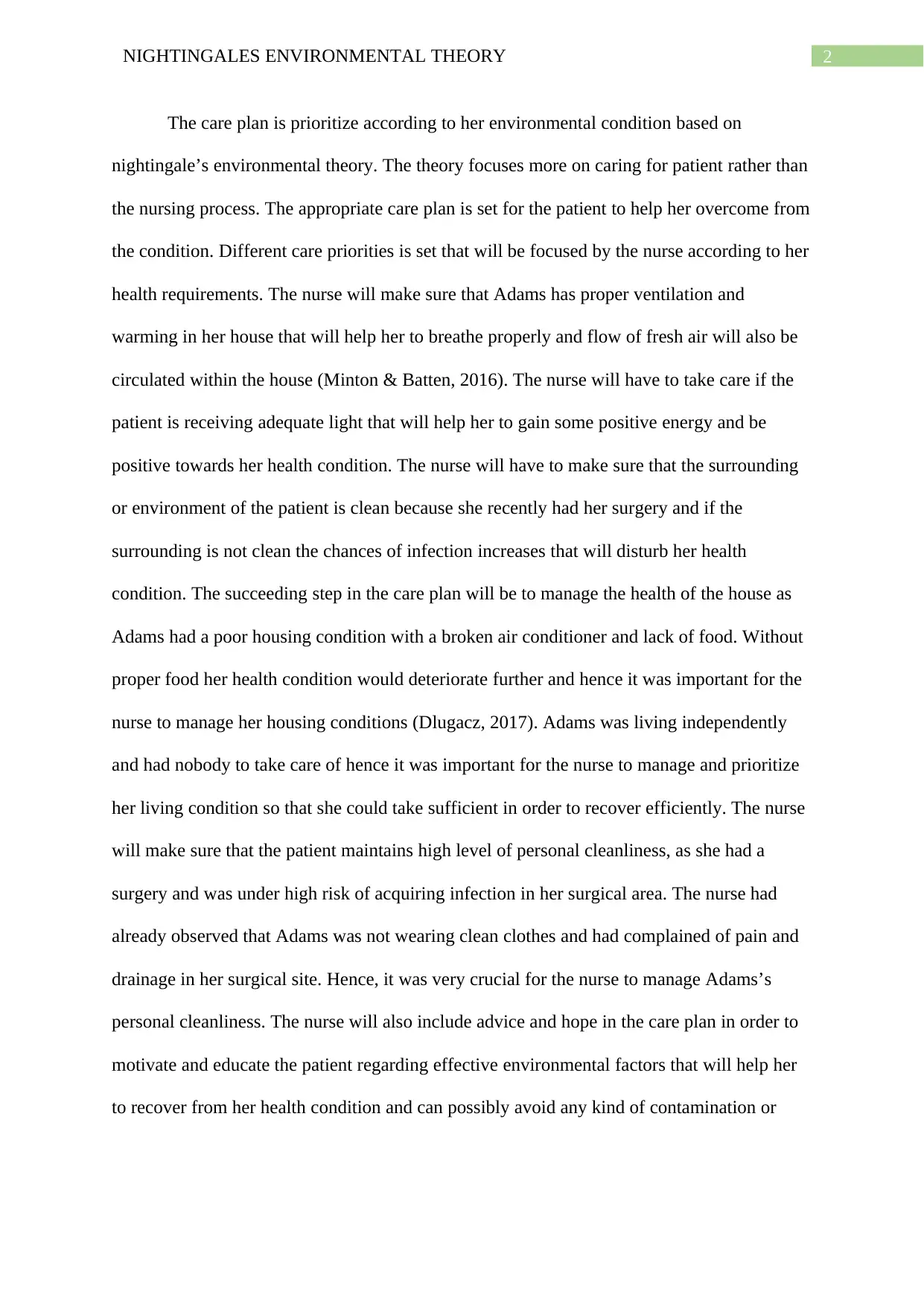
2NIGHTINGALES ENVIRONMENTAL THEORY
The care plan is prioritize according to her environmental condition based on
nightingale’s environmental theory. The theory focuses more on caring for patient rather than
the nursing process. The appropriate care plan is set for the patient to help her overcome from
the condition. Different care priorities is set that will be focused by the nurse according to her
health requirements. The nurse will make sure that Adams has proper ventilation and
warming in her house that will help her to breathe properly and flow of fresh air will also be
circulated within the house (Minton & Batten, 2016). The nurse will have to take care if the
patient is receiving adequate light that will help her to gain some positive energy and be
positive towards her health condition. The nurse will have to make sure that the surrounding
or environment of the patient is clean because she recently had her surgery and if the
surrounding is not clean the chances of infection increases that will disturb her health
condition. The succeeding step in the care plan will be to manage the health of the house as
Adams had a poor housing condition with a broken air conditioner and lack of food. Without
proper food her health condition would deteriorate further and hence it was important for the
nurse to manage her housing conditions (Dlugacz, 2017). Adams was living independently
and had nobody to take care of hence it was important for the nurse to manage and prioritize
her living condition so that she could take sufficient in order to recover efficiently. The nurse
will make sure that the patient maintains high level of personal cleanliness, as she had a
surgery and was under high risk of acquiring infection in her surgical area. The nurse had
already observed that Adams was not wearing clean clothes and had complained of pain and
drainage in her surgical site. Hence, it was very crucial for the nurse to manage Adams’s
personal cleanliness. The nurse will also include advice and hope in the care plan in order to
motivate and educate the patient regarding effective environmental factors that will help her
to recover from her health condition and can possibly avoid any kind of contamination or
The care plan is prioritize according to her environmental condition based on
nightingale’s environmental theory. The theory focuses more on caring for patient rather than
the nursing process. The appropriate care plan is set for the patient to help her overcome from
the condition. Different care priorities is set that will be focused by the nurse according to her
health requirements. The nurse will make sure that Adams has proper ventilation and
warming in her house that will help her to breathe properly and flow of fresh air will also be
circulated within the house (Minton & Batten, 2016). The nurse will have to take care if the
patient is receiving adequate light that will help her to gain some positive energy and be
positive towards her health condition. The nurse will have to make sure that the surrounding
or environment of the patient is clean because she recently had her surgery and if the
surrounding is not clean the chances of infection increases that will disturb her health
condition. The succeeding step in the care plan will be to manage the health of the house as
Adams had a poor housing condition with a broken air conditioner and lack of food. Without
proper food her health condition would deteriorate further and hence it was important for the
nurse to manage her housing conditions (Dlugacz, 2017). Adams was living independently
and had nobody to take care of hence it was important for the nurse to manage and prioritize
her living condition so that she could take sufficient in order to recover efficiently. The nurse
will make sure that the patient maintains high level of personal cleanliness, as she had a
surgery and was under high risk of acquiring infection in her surgical area. The nurse had
already observed that Adams was not wearing clean clothes and had complained of pain and
drainage in her surgical site. Hence, it was very crucial for the nurse to manage Adams’s
personal cleanliness. The nurse will also include advice and hope in the care plan in order to
motivate and educate the patient regarding effective environmental factors that will help her
to recover from her health condition and can possibly avoid any kind of contamination or
⊘ This is a preview!⊘
Do you want full access?
Subscribe today to unlock all pages.

Trusted by 1+ million students worldwide
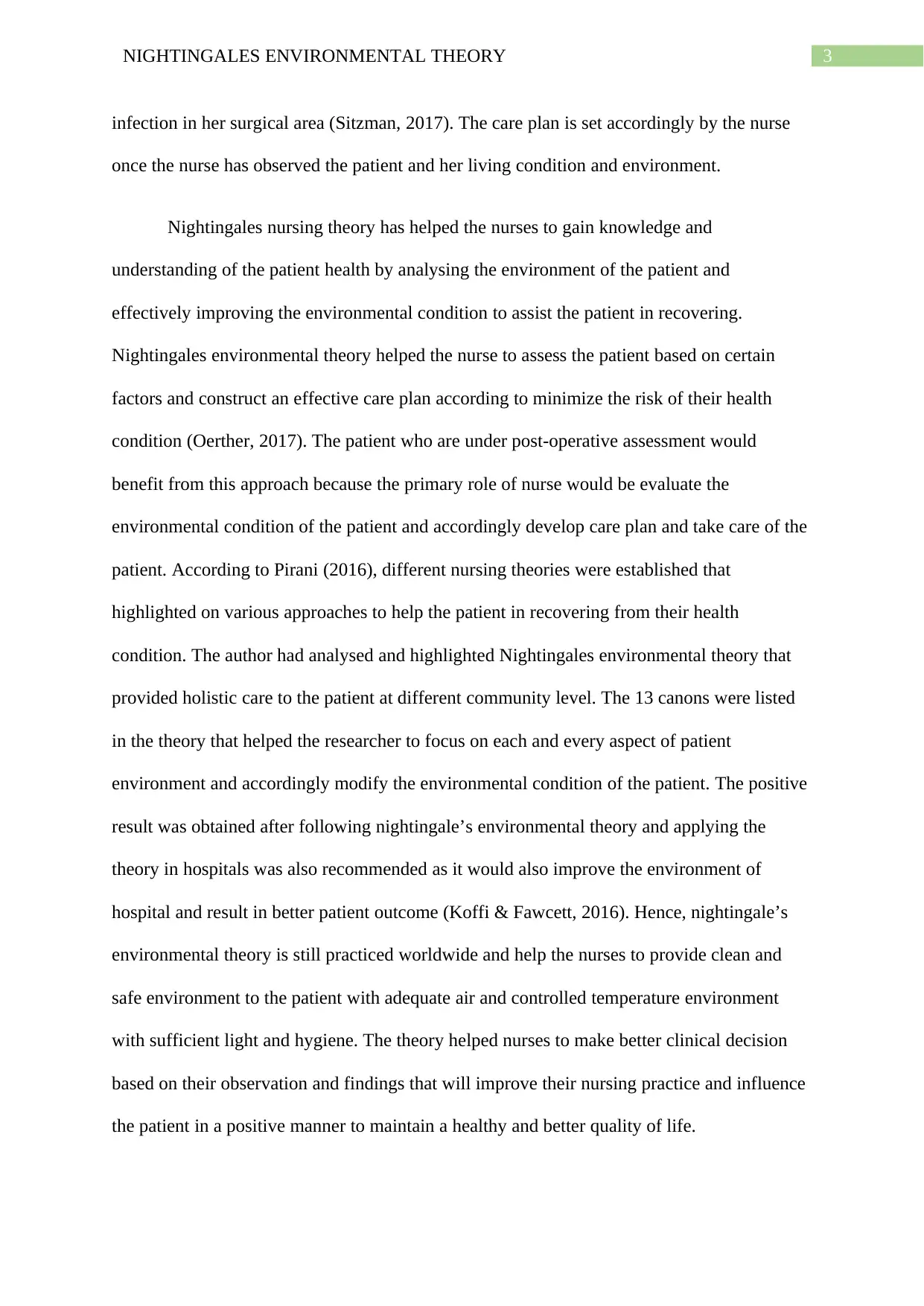
3NIGHTINGALES ENVIRONMENTAL THEORY
infection in her surgical area (Sitzman, 2017). The care plan is set accordingly by the nurse
once the nurse has observed the patient and her living condition and environment.
Nightingales nursing theory has helped the nurses to gain knowledge and
understanding of the patient health by analysing the environment of the patient and
effectively improving the environmental condition to assist the patient in recovering.
Nightingales environmental theory helped the nurse to assess the patient based on certain
factors and construct an effective care plan according to minimize the risk of their health
condition (Oerther, 2017). The patient who are under post-operative assessment would
benefit from this approach because the primary role of nurse would be evaluate the
environmental condition of the patient and accordingly develop care plan and take care of the
patient. According to Pirani (2016), different nursing theories were established that
highlighted on various approaches to help the patient in recovering from their health
condition. The author had analysed and highlighted Nightingales environmental theory that
provided holistic care to the patient at different community level. The 13 canons were listed
in the theory that helped the researcher to focus on each and every aspect of patient
environment and accordingly modify the environmental condition of the patient. The positive
result was obtained after following nightingale’s environmental theory and applying the
theory in hospitals was also recommended as it would also improve the environment of
hospital and result in better patient outcome (Koffi & Fawcett, 2016). Hence, nightingale’s
environmental theory is still practiced worldwide and help the nurses to provide clean and
safe environment to the patient with adequate air and controlled temperature environment
with sufficient light and hygiene. The theory helped nurses to make better clinical decision
based on their observation and findings that will improve their nursing practice and influence
the patient in a positive manner to maintain a healthy and better quality of life.
infection in her surgical area (Sitzman, 2017). The care plan is set accordingly by the nurse
once the nurse has observed the patient and her living condition and environment.
Nightingales nursing theory has helped the nurses to gain knowledge and
understanding of the patient health by analysing the environment of the patient and
effectively improving the environmental condition to assist the patient in recovering.
Nightingales environmental theory helped the nurse to assess the patient based on certain
factors and construct an effective care plan according to minimize the risk of their health
condition (Oerther, 2017). The patient who are under post-operative assessment would
benefit from this approach because the primary role of nurse would be evaluate the
environmental condition of the patient and accordingly develop care plan and take care of the
patient. According to Pirani (2016), different nursing theories were established that
highlighted on various approaches to help the patient in recovering from their health
condition. The author had analysed and highlighted Nightingales environmental theory that
provided holistic care to the patient at different community level. The 13 canons were listed
in the theory that helped the researcher to focus on each and every aspect of patient
environment and accordingly modify the environmental condition of the patient. The positive
result was obtained after following nightingale’s environmental theory and applying the
theory in hospitals was also recommended as it would also improve the environment of
hospital and result in better patient outcome (Koffi & Fawcett, 2016). Hence, nightingale’s
environmental theory is still practiced worldwide and help the nurses to provide clean and
safe environment to the patient with adequate air and controlled temperature environment
with sufficient light and hygiene. The theory helped nurses to make better clinical decision
based on their observation and findings that will improve their nursing practice and influence
the patient in a positive manner to maintain a healthy and better quality of life.
Paraphrase This Document
Need a fresh take? Get an instant paraphrase of this document with our AI Paraphraser
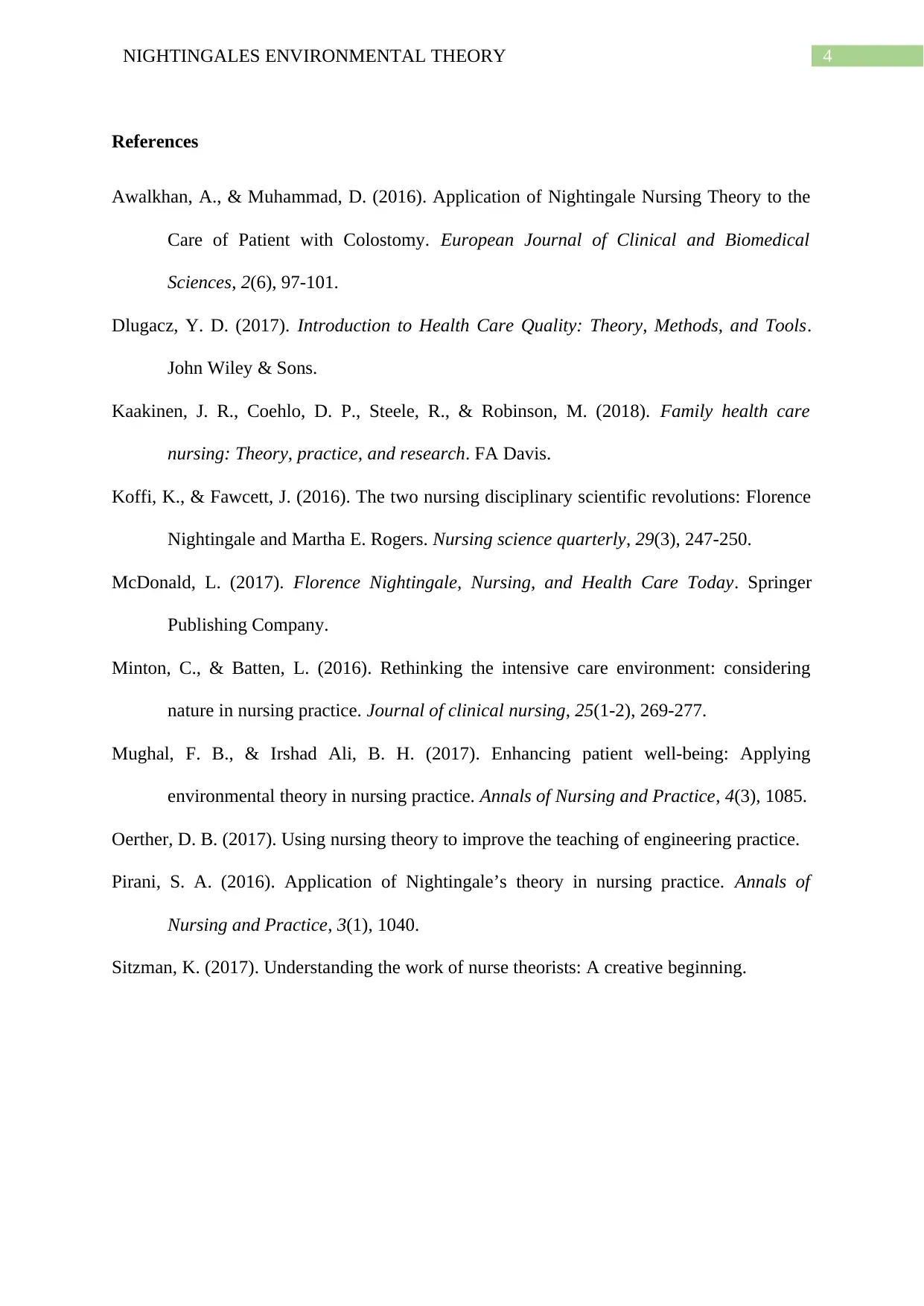
4NIGHTINGALES ENVIRONMENTAL THEORY
References
Awalkhan, A., & Muhammad, D. (2016). Application of Nightingale Nursing Theory to the
Care of Patient with Colostomy. European Journal of Clinical and Biomedical
Sciences, 2(6), 97-101.
Dlugacz, Y. D. (2017). Introduction to Health Care Quality: Theory, Methods, and Tools.
John Wiley & Sons.
Kaakinen, J. R., Coehlo, D. P., Steele, R., & Robinson, M. (2018). Family health care
nursing: Theory, practice, and research. FA Davis.
Koffi, K., & Fawcett, J. (2016). The two nursing disciplinary scientific revolutions: Florence
Nightingale and Martha E. Rogers. Nursing science quarterly, 29(3), 247-250.
McDonald, L. (2017). Florence Nightingale, Nursing, and Health Care Today. Springer
Publishing Company.
Minton, C., & Batten, L. (2016). Rethinking the intensive care environment: considering
nature in nursing practice. Journal of clinical nursing, 25(1-2), 269-277.
Mughal, F. B., & Irshad Ali, B. H. (2017). Enhancing patient well-being: Applying
environmental theory in nursing practice. Annals of Nursing and Practice, 4(3), 1085.
Oerther, D. B. (2017). Using nursing theory to improve the teaching of engineering practice.
Pirani, S. A. (2016). Application of Nightingale’s theory in nursing practice. Annals of
Nursing and Practice, 3(1), 1040.
Sitzman, K. (2017). Understanding the work of nurse theorists: A creative beginning.
References
Awalkhan, A., & Muhammad, D. (2016). Application of Nightingale Nursing Theory to the
Care of Patient with Colostomy. European Journal of Clinical and Biomedical
Sciences, 2(6), 97-101.
Dlugacz, Y. D. (2017). Introduction to Health Care Quality: Theory, Methods, and Tools.
John Wiley & Sons.
Kaakinen, J. R., Coehlo, D. P., Steele, R., & Robinson, M. (2018). Family health care
nursing: Theory, practice, and research. FA Davis.
Koffi, K., & Fawcett, J. (2016). The two nursing disciplinary scientific revolutions: Florence
Nightingale and Martha E. Rogers. Nursing science quarterly, 29(3), 247-250.
McDonald, L. (2017). Florence Nightingale, Nursing, and Health Care Today. Springer
Publishing Company.
Minton, C., & Batten, L. (2016). Rethinking the intensive care environment: considering
nature in nursing practice. Journal of clinical nursing, 25(1-2), 269-277.
Mughal, F. B., & Irshad Ali, B. H. (2017). Enhancing patient well-being: Applying
environmental theory in nursing practice. Annals of Nursing and Practice, 4(3), 1085.
Oerther, D. B. (2017). Using nursing theory to improve the teaching of engineering practice.
Pirani, S. A. (2016). Application of Nightingale’s theory in nursing practice. Annals of
Nursing and Practice, 3(1), 1040.
Sitzman, K. (2017). Understanding the work of nurse theorists: A creative beginning.
1 out of 5
Related Documents
Your All-in-One AI-Powered Toolkit for Academic Success.
+13062052269
info@desklib.com
Available 24*7 on WhatsApp / Email
![[object Object]](/_next/static/media/star-bottom.7253800d.svg)
Unlock your academic potential
Copyright © 2020–2025 A2Z Services. All Rights Reserved. Developed and managed by ZUCOL.





